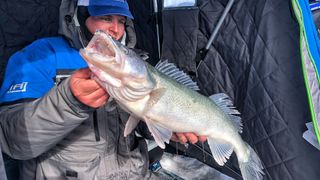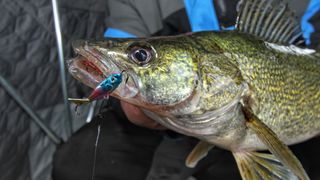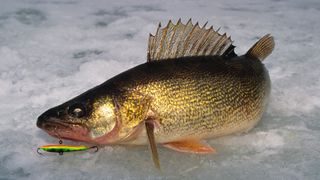How to catch walleye: the best bait, lures, tackle and set-ups for ice fishing success
Pro-angler Jason Mitchell reveals how to catch walleye with the best ice fishing methods, tactics and tips

Learning how to catch walleye – famed for their ferocious looks and bristling fins – can be a challenge for any angler, particularly as one of the best times to target this distinctive fish is in the depths of winter through the ice. However, with these tips from pro angler Jason Mitchell for the best tactics, lures, tackle, set-ups and times for walleye fishing, you'll soon be racking up the trophy 'eyes on your next ice fishing trip.
Walleye are an extremely popular fish wherever they’re found and are highly coveted by fishing enthusiasts for their willingness to feed regardless of the season. The world record catch is close to 20lb but most weigh in at a handful of pounds, coming armed with needle teeth and a huge dorsal fin regardless of size. They fight well and taste great fried, baked or smoked – all factors in making them a worthwhile target for anglers wherever they're found across the US or Canada.
In many places with sufficiently cold weather and suitable waterways, there are ample opportunities to target walleye on rod and line through the ice and this is what we’ll focus on in this guide with lots of tips, tactics and set-ups you can use for your best walleye fishing season ever. Let's start with the best locations for walleye fishing.
- Reel ’em in with the best ice fishing rods you can buy
- Everything you need to know: How to go ice fishing: a beginner's guide
- You'll catch more if you know when to go: the best fishing times
How to catch walleye: The best places and locations to go ice fishing for walleye
There can be major differences that exist from one fishery to the next but by and large, walleye are very structure-orientated, which means they're unlikely to be found in featureless open water spots. Points, reefs, sunken islands and any significant transitions in the bottom contours are some of the best locations that can attract walleye.
The first key to knowing how to catch walleye whilst ice fishing is finding them, so learn to read lake maps and find structure when the waterway is frozen over. Sunken points or islands are obvious pieces of structure that often hold walleye, and are favorite areas to target first through the ice. If you have a smartphone, download an app like the Navionics App to give you general contour maps of the water you are fishing so that you can find this structure faster. Local maps showing lake contours are also useful tools, and a fish finder will change the game entirely when it comes to working precise spots and structure.
You can also check out our expert guide explaining how to use a fish finder for ice fishing.
How to catch walleye: The best times to go ice fishing for walleye
While there are major exceptions like Lake of the Woods in northern Minnesota that produce great walleye fishing throughout the duration of the day, expect most of the action to occur on most fisheries right around sunrise or sunset. Some bodies of water also produce fish after dark. During these lowlight conditions, walleye will move up on to structure like sunken islands or points to prey on baitfish that have also congregated here. If you've already identified these likely feeding areas and are in position at these key times of dawn and dusk, you'll be maximizing your chances of hitting that feeding window and catching lots of walleye.

How to catch walleye: The best baits, lures and tactics for ice fishing for walleye
As a rule of thumb, walleye are predators eating smaller fish. The primary forage could be fish like smelt or baitfish. Might be yellow perch or spot tail shiners, could be gizzard shad. Identifying the primary forage on the lake you plan to ice fish can help you locate fish because walleye are never far from their next meal. Through the ice, most walleye are caught using lures like spoons or glide baits that look like a small fish or using set lines that are rigged or tipped with some type of minnow or shiner to match the local delicacy.
In most states and provinces, ice anglers can use more than one line. Many ice anglers incorporate a one-two punch where anglers will actively jig a spoon or glide bait like the classic Jigging Rap or Clam Tikka Mino and use set lines rigged with lively minnows or shiners nearby.
Advnture Newsletter
All the latest inspiration, tips and guides to help you plan your next Advnture!
As a rule of thumb, most anglers will fish a foot or two off the bottom but some exceptions do exist. On Lake Erie for example, anglers often fish much higher in the water column because many of the fish will suspend and the water is so clear that fish can see the presentation from much further away.
Aggressively jig the lure to look for and find aggressive fish. If fish will not respond to the aggressive presentations, the set line with a live minnow will often catch less aggressive fish. Depending on the lure, many ice anglers will jig spoons and glide baits with a one- or two-foot stroke. When fish hit jigged lures, the strikes are often very hard and distinct.
- How to choose fishing bait: a top angler gives their tips
- How to go night fishing: strategies, kit, baits and lures

How to catch walleye: The best tackle and set-ups for walleye fishing through the ice
For both set lines and jigging lures, many anglers will use a 6-8lb monofilament main line but some anglers prefer to jig with braided line tipped with a fluorocarbon leader. Braid has zero stretch so gives a more direct feel in feeling delicate bites compared to stretchy mono main lines, and the fluorocarbon line is harder for the fish to see compared to mono, giving you another slight advantage in clear water in daylight.
A 28”/71cm to 36”/91cm medium-fast action spinning rod action is preferred by many for jigging. For set lines, which are lines that are left to fish themselves rather than actively worked by the angler, many ice anglers like to use a softer-tipped spinning rod where you can watch the minnow get excited on the rod tip when a predator shows up. A good set line rod should have a soft tip yet stiff backbone so that you can watch the rod tip dunk down when a fish hits, yet still have backbone for setting the hook.
- The best fishing line: tried and tested favourites for every situation
- How to choose fishing line: catch the fish you want with mono, braided or fluoro on your reel

How to catch walleye: The best set line set-ups for ice fishing for walleye
Set line set-ups, which are lines left for a period to fish themselves with a bite indicated by a flag device, can vary by region but at the end of the day, many walleyes get caught each winter with a simple split shot (a small weight that clips on the line) and a number four or six baitholder-style hook tipped with a live minnow or shiner. In some regions, however, there is big fish potential and these fish prefer much bigger baits like sucker minnows. For presenting sucker minnows that might be six inches or longer, nothing beats a simple tip-up.
Tip-ups have a spool that typically rests or hangs under the water and when the spool turns, a flag pops up indicating a bite. Many anglers will spool up tip-ups with a heavier 14-20lb dacron (a type of braided main line) and use an 8-10lb fluorocarbon or monofilament leader that might range between two and four feet in length.
For using big sucker minnows, many anglers will use a split shot large enough to sink the minnow and a size four treble hook. For both minnows and suckers, hook the bait by nicking the hide or back so that the minnow can swim around lively.
Now go enjoy some great ice fishing for walleye
Great ice fishing for walleye occurs in so many locales each winter – they’re also a popular fish that is noted for being good fare on the table. Whilst walleye can be temperamental with distinct feeding windows, make no mistake that walleye are a top tier predator on many bodies of water, but also a fish that can be extremely aggressive one evening and completely lethargic the next.
Walleyes are often notorious for being nomadic, too, showing up on a new location overnight. They’re certainly a challenging-yet-rewarding target that continues to infatuate so many anglers, which is why learning how to catch walleye is such a great journey for any angler to go on. With these tips, we’re sure your next walleye session will be a success and you’ll see why so many flock to this species and their haunts every year. Take good care on the ice, as always, and tight lines!
Midwesterner Jason Mitchell is the star of his own outdoors TV show and a leading expert when it comes to many styles of freshwater and ice fishing. He’s helped millions of people catch species such as crappie, walleye, perch, bass, trout, panfish and catfish through his information-packed programmes and articles. Needless to say, Jason is also an expert on fishing tackle, angling accessories and electronics.
